by tmoffett | Oct 22, 2010 | Color, Landscape, Photographic Philosophy
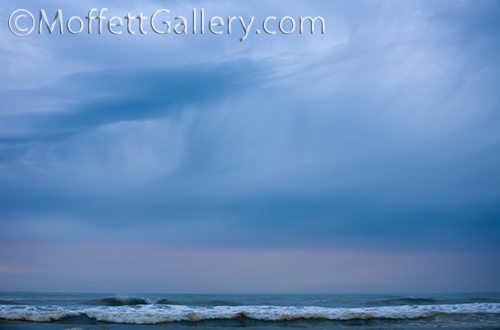
Stormy Sunset, Seaside Oregon
Simplicity in an image brings power. This is a hard concept for beginning photographers to grasp. In our complex lives it is hard to cut out the clutter in our minds and recognize the simple things that are so beautiful. This goes not only for image making, but for our lives as well. Because multitasking is normal, our minds have a difficult time slowing down, if even for a moment. While difficult to do, it has become a necessity for me. I take time to ponder and meditate, to not only look but truly see, not just touch but feel my environment. As I take time to absorb my surroundings I am better able to reduce a scene, visually, to its foundation which is where its beauty lies. Only then am I able to capture it simply and emotionally.
My process when photographing is not fast. It is slow and thoughtful. Often I will set up my tripod and camera and then look and think and ponder. “What drew me into the scene?” “Why did I set up my camera here?” These and numerous other questions go through my mind as I determine what it is that the image is to be about. Then I check the viewfinder and check it again, set exposure settings and check the viewfinder again. Eventually I press the shutter. The entire process is an experience. The whole experience becomes the photograph, an image that hopefully can be felt by the viewer, but if not, it is experienced by me and I am satisfied.
by tmoffett | Oct 20, 2010 | Black and White, Composition, Landscape
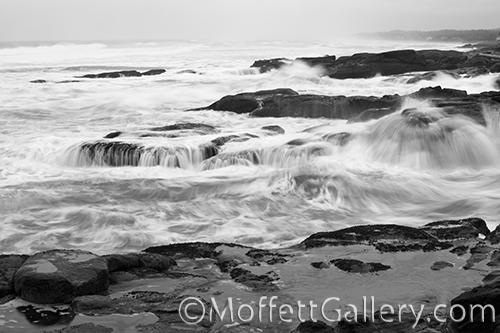
Oregon Shoreline
This image from the Shorelines Portfolio shows a stark contrast from the calm image that I posted yesterday. Using a faster shutter speed, I was able to maintain a greater feeling of turbulence in the ocean as the waves crash into the rock outcroppings along the shore. When photographing moving water, shutter speed selection is critical. Use a very slow shutter speed and all of the motion is smoothed out, sometimes to the extent of being mushy and washed out, lacking detail. Too fast of a shutter speed and every drop of water is frozen in space. The in between shutter speeds are what I usually work with, getting a perfect blend of detail and movement.
I had been to this location before at high tide, so arriving in the dark just prior to low tide this time, I had no idea what I might find. I was not disappointed. As the sun crept over the horizon, I found many tide pools filled with sea stars and other ocean life. I also found this composition waiting to be photographed. I love the still water reflecting the overcast sky on the dark rock in the foreground with the turbulence of a raging sea behind it. The image, to me, is all about turbulence in life and finding peace as we rise above it. Hindsight is 20/20. When rising above the trial, we look back and can see the beauty of where we have passed.
by tmoffett | Oct 19, 2010 | Black and White, Composition, Landscape
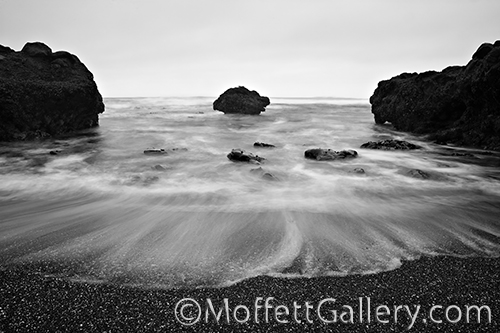
Floating Rock, Yachats, Oregon
Dead Center. A colleague of mine was given this nickname in college because she loved symmetrical compositions. The main subject always in dead center. I dedicate this image to her.
I am always teaching and preaching the Rule of Thirds and the Golden Mean. If my students learn nothing else about composition, they better know understand those. So why do I occasionally not use them? Because it works! When deviating from a tried and true technique, such as the Rule of Thirds, there better be a reason for it. In this image, there is. The outcropping rock on each side of center appear to point to the center rock and then the water coming forward breaks up the composition enough to add interest and direction. The edge of the water in the foreground give a defining edge that completes a circular composition, giving the viewers eye a place to go, preventing it from stagnating in the center of the image as so many dead center compositions do.
I love off center compositions that maintain a visual balance, however it is good to break it up once in a while and do something different. Just make sure there is a reason for it and that it works visually. Like I tell my students, “Rules were meant to be broken, but you better have a reason for it!”
by tmoffett | Oct 18, 2010 | Color, Landscape, Photographic Philosophy
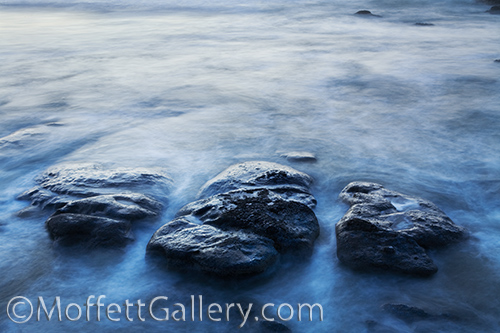
Pacific Wonder
My best photographs are made when I am in a “zone,” so to speak. I am oblivious to the many distractions around me and am in tune with my subject matter. In the landscape, I am in touch with nature. I can feel the crisp air, smell the scents of nature, hear every sound from the rushing water to the birds chirping. It is an experience. The images created are a reflection of the experience. Hopefully they create a visual and emotional experience for the viewer.
Technique plays a very important part in creating the visual experience, however it is not something that I am constantly thinking about. It has become a part of me. It just happens. Otherwise it would possibly get in the way of the creative experience. In the formative years of my photographic career I spent many hours honing technique. I studied. I photographed. I printed in the darkroom. I photographed more. I read more. I studied more. I worked harder. I made mistakes. I tried to learn from my mistakes. Photography slowly became a part of me.
I continue to read and study. I love working with other photographers. But when I photograph, I photograph. The technique just happens. I don’t question what I do. I just do it. I often am amazed at the results. When I listen to my inner self, good things happen. My own feelings are evident in the images created in this manner. It is as though I am opening up my innermost feelings and passions to the entire world, yet there is enough room for personal interpretation that the viewer may see something completely different. I can see myself in my images while others may not. I like it that way. For that reason I will rarely discuss the “meaning” of my images. I prefer the engaged viewer to determine meaning. I feel better that way. And that to me is what photography is all about. Feeling.
by tmoffett | Oct 16, 2010 | Color, Composition, Landscape, Photographic Philosophy, Uncategorized
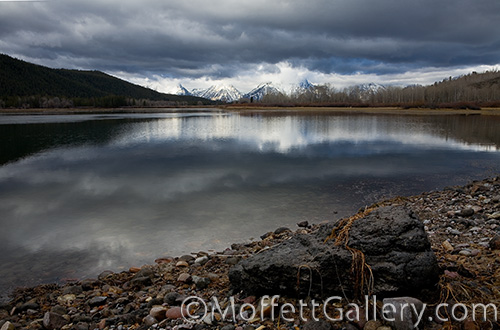
The Tetons
Landscape photography is so much more than just snapping pictures of scenic areas. We must deal with finding a the scene, analyzing composition and working with the light that nature gives us. That doesn’t mean that we make photographs of scenic places under the light that is there when we conveniently decide to be there, wherever there is. It means that we may get up at 4:00 AM and go out in the winter cold in order to arrive and be ready when the morning light first breaks over the horizon. It may mean that we suffer in the late summer heat to find our location and composition and then patiently wait for the setting sun to deliver the quality of light needed to create the mood in our photograph to say what we want it to say. Some days I will set up and wait, only to have the light fizzle out and not deliver. That’s okay. It’s just part of being a photographer.
Learning your craft, really learning it, is a major part of becoming an artist. We must understand the technical aspects of the camera and composition first, and then when photographing from the heart we are able to create masterpieces without having to think logically during the process. We can truly work on an emotional level only when we can work on the technical level without thinking about it. It must become a part of us. I see many students who refuse to learn and master the technical and then wonder why their photographs do not have the emotional impact that they would like. Photography is a blend of art and science, and we must comprehend both if we are to master our craft.







Recent Comments